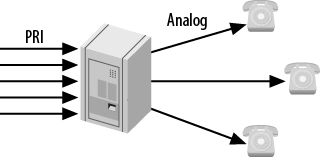Most systems deployed before the year 2000 will look quite similar. They will involve a set of phone lines delivered either via a PRI or through an array of analog lines, which connect to a PBX system that delivers calls to handsets that are likely proprietary to the systems deployed. These systems will likely provide a basic set of functions, with extra functions such as voicemail and conferencing being provided through external modules that may cost thousands of dollars. This topology is illustrated in Figure 22.1, “Traditional call center”.
Such systems will utilize a set of rules for delivering calls to agents through the standard automatic call distribution (ACD) rules, and will have little flexibility. It will likely be either impossible or expensive to add remote agents, as the calls would need to be delivered over the PSTN, which utilizes two phone lines: one for the incoming caller to the queue, and another to be delivered to the remote agent (in most cases, the agents just need to reside at the same physical location as the PBX itself).
These traditional phone systems are slowly being phased out, though, as more people start clamoring for the features VoIP brings to the table. And even for systems that aren’t going to be using VoIP, solutions like Asterisk bring to the table features that once cost thousands of dollars as an included part of the software.
Of course, with the money invested in expensive hardware in traditional systems, it is natural that organizations with these systems will want to get as much use from them as possible. Plus, simply swapping out an existing system is not only expensive (wiring costs for SIP phones, replacement costs for proprietary handsets, etc.), but may be invasive to the call center, especially if it operates continuously.
Perhaps, though, the time to expand has come, and the existing system is no longer able to keep up with the number of lines required and the number of seats necessary to keep up with demand. In this case, it may be advantageous to look toward a hybrid system, where the existing hardware continues to be used, but new seats and features are added to the system using Asterisk.
